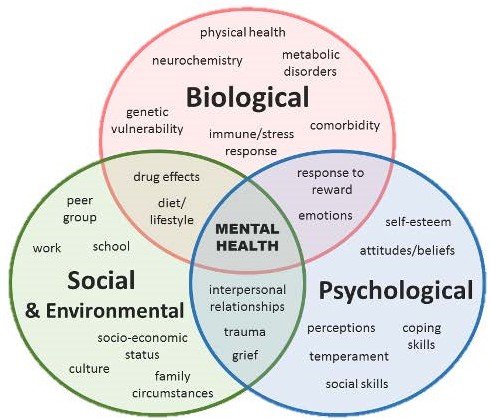The Biopsychosocial Model for Mental Health
In therapy, it is common to think about seeking treatment specifically for your mental health, but receiving therapy involves more than just the psychological factor of your presenting issues. Incorporating the biopsychosocial model in the therapeutic process allows for exploration of biological, psychological, and social aspects in relation to your overall well-being.
What is the Biopsychosocial Model?
The biopsychosocial model creates a holistic view to explore the biological, psychological, and social factors of your life. It is important to understand that your mental health (psychological) is interconnected and works in conjunction with the physiological and social features; otherwise known as the mind-body connection. Therapists recognize the importance of the biopsychosocial model when treating clients for specific issues and identify that not one can be addressed without the other.
The Biological
Biological change in the body can be an influence in a person’s psychological being. Some biological factors include:
Gender
Nutrition
Disease
Immune-deficiency
Genetic vulnerability
Physical Illness
Disability
The Psychological
Changes in a person’s thoughts can lead to certain behaviours. The following are examples of psychological factors:
Personality
Cognitions
Attitudes, Values & Beliefs
Memory
Behaviours
Regulating and Coping skills
Trauma (PTSD)
The Social
A person’s behaviours can have an impact in correlation with social factors in a person’s life. Social aspects of a person’s life can include, but are not limited to:
Social Support
Family Background
Cultural Traditions
Socioeconomic Status
Education
Society
Community
Below, you will see the biopsychosocial model of mental health:
As clinicians apply the biopsychosocial model, they consider all science-based aspects of the individual’s health, but also recognize that humanistic relationships (social) are imperative in providing overall health care. In utilizing the biopsychosocial model, practitioners can also decipher biological, psychological, and social aspects that are pertinent in providing multidimensional treatment within the therapeutic process.
The biopsychosocial model allows for a variety of interventions, while eliminating specific guidelines for a therapeutic plan. The model, with its interconnectedness, exhausts all the possible ways clinicians can collaborate to provide an effective treatment for the client’s issues.
If you would like to learn more about the biopsychosocial model in the therapeutic process, please do not hesitate to contact us for more information!



